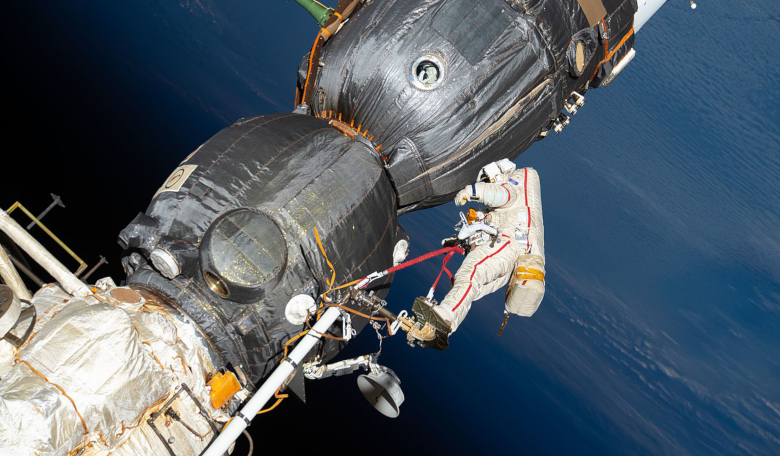A cloth and some glue might not seem a high-tech way in which to fix a hole in a spacecraft orbiting above Earth, but that is how astronauts filled the breach on a Soyuz MS-09 spacecraft docked to the International Space Station when it was found in 2018. Now, according to Russian news site RIA, the company behind the manufacturers of the Russian rocket have patented that very same fix for sealing holes in space.
The hole was discovered when sensors aboard the ISS detected a slow loss of cabin air pressure on the space station, alerting the onboard astronauts to a leak on the upper module of the Soyuz MS-09 spacecraft docked to the Russian Rassvet module.
At the time, the hole caused considerable controversy as the 2-millimeter (0.08 inch) cavity appeared not to be the result of a tiny meteorite strike, but had the hallmark of a deliberate hole drilled by someone on the ground prior to liftoff.
It was suggested that instead of a natural accident, someone mistakenly drilled the hole during pre-flight processing and then attempted to cover up the mistake by applying a sealant of some sort. However when the Soyuz reached the ISS the sealant “dried up and fell off” leaving behind a noticeable hole.
An investigation has since been launched, but the results surrounding the hole’s origin have not yet been publicly announced and it is unclear whether they still will be or not.
Whatever the cause, whether man-made or meteorite, RSC Energia, the prime developer and contractor of the Russian manned spaceflight program, have now patented a method for fixing similar space-based holes with a cloth and glue; the patent and its description have been published by the Federal Service for Intellectual Property.
"The objective of the invention was the development of a method for sealing a defect in the form of an opening in the shell of a manned spacecraft with a characteristic size of up to ten millimeters in a space flight when air flows through it into the surrounding space," the patent explains.
According to the Russian news site, it states “that the patented method is suitable for sealing holes from micrometeorites, space debris and holes accidentally punched by astronauts, that is, made "due to erroneous actions of the crew during repairs on the shell of a manned spacecraft."
The hole is to be plugged with a towel and sealant and then checked with an ultrasonic leak detector. If necessary, a few more layers of glue can be applied to strengthen the fix.
The Expedition 56 crew who found the hole in the Soyuz MS-09 spacecraft, used a cloth soaked with a special adhesive composition called “Germetall,” that can be used for waterproofing. According to ISS reports, Germetall-1 is a sealant that was used in the GERMETIK leak repair kit that was available for use on the ISS.
As patents are a form of intellectual property that gives its owner the legal right to exclude others from making, using, selling and importing an invention for a limited period of years, the question now arises how RSC Energia’s patent affects someone in space who comes across a similar problem. Would they have to ask the firm for permission to use a glue or a cloth, or would a different sealant suffice?











